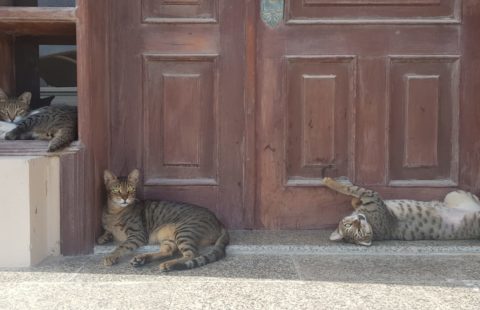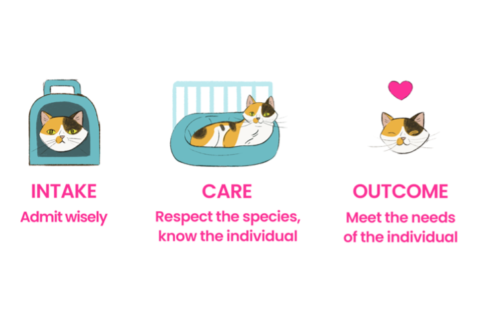It is inspiring to read articles from people like Pauline who saw a cat problem and committed to do her very best to resolve it. Good intentions sadly are not enough and a great deal of planning and hard work goes into these projects before a single cat is directly involved. If you want to help street cats in your area, here are some of the things that you would need to consider
Rushing in alone to do TNR without the right support, equipment, knowledge and plan can cause significant problems for both you and the cats. You need to have a real understanding of how the cats came to be there, what problems they face and what issues they are causing for the local community. You also need to get to know the environment you will be operating in.
First things first – collaborate!
A number of different skills are required to run a successful TNR programme, it is unlikely that one person will have all those skills or be able to function alone. Working in a team with like-minded people means that you have greater resources and a broader range of skills. You will need:
Communication – you, or a member of your team will need to liaise with the community, veterinarians and other local organisations and get them on your side to make this happen.
Organisation – there is a lot for you to consider and a number of different aspects that you will need to coordinate – it needs a structured plan, even if you delegate that role to another member of your team, it needs to be done.
Good knowledge of cats and their welfare – we all love cats but unless we actively seek out knowledge about them it is possible to make some wrong assumptions about what is best for them. It is always easier to plan successful TNR programmes that provide good welfare for the cats involved if you have the right knowledge to make life-changing decisions on their behalf.
Courage – There are some distressing aspects to this work, dealing with sick or injured cats. Can you be confident to make pragmatic, humane decisions including euthanasia where there is no better choice? How would you cope with angry, abusive people who may not understand what you are trying to do or why you are doing it? You need to be able to cope with this and bounce back, which is often not easy.
Patience – You will spend endless hours, days and even weeks trapping a colony of cats – this takes stamina, patience and determination. You need to work with a group of people who are willing and able to put the hours in to get the results If you cannot imagine doing this yourself.
Once you have your team together you can begin to plan. You can methodically go through all the things you need to consider:
Legality – what is the legal position in your country or region?
- Can you legally intervene?
- Is there any infrastructure in the form of government or animal organisations already addressing the issue and are they aware of the problem?
- Is there a local/national authority involved in developing solutions such as legislation and animal control systems?
- Are there laws concerning trapping/neutering and the ownership/responsibility for unowned cats?
- Who ‘owns’ the cats you are trying to help and the land they are on? Is there someone who you need to seek permission from to trap?
The cats – what do you know about them?
- Why is this cat population there and what impact are they having on people and wildlife?
- Do you have evidence to support that cats are a problem and intervention is needed?
- Are all the cats in the area unowned or do people consider them to be pets (even if others do not)?
- Are there just feral and street/community cats or are there stray and abandoned pet cats too? Are there pet cats in the area? Do you have a plan for what you will do with each type?
The problem – will TNR resolve the issue you are trying to address?
- Are cats impacting on a particularly rare or fragile ecosystem and so cannot remain in their current location?
- Is the cats’ welfare poor because of infectious or genetic diseases?
- Is the site being developed and so cats cannot be returned?
- Is the problem the nuisance caused by noise, smell or concerns about hygiene and disease?
- Is the problem with waste from the cats in areas where it may cause problems for human health (for example, where water is collected)? In this case return of cats (even if neutered) will not solve the problem.

Waste from cats that congregate on roofs can contaminate rainwater that may be an important source of water for the local community
The community – what is their attitude towards the cats and how can you engage them to assist?
- Is the community’s attitude towards cats generally positive or negative and how does this impact on population control plans? High levels of negativity from a significant proportion of the community will reduce the effectiveness of TNR programmes and may lead to poor welfare outcomes for cats even if they are neutered. Without the involvement and cooperation of local people, you will not be successful
- Are there cultural or religious beliefs that may influence people’s responses?
- Are there other factors that the community values? It may be helpful to capture this information via questionnaires or discussions before and after trapping. This can help you to measure success from their point of view, for example, there may have been concerns about cats fighting and making a noise at night and this problem may have been solved.
The veterinarians – are their local vets willing and able to neuter and treat the cats?
- Will you be using veterinarians in a large charity hospital? If not, those you use will be running their own business and you will need to respect this when asking for discounted rates and arranging time for neutering. Veterinarians play an essential role in your TNR project, so good working relationships are necessary
- Do they understand the issues around dealing with feral and street cats and have the equipment and know-how to do so?
- Will they need additional equipment or to introduce different anaesthetic protocols?
- Are there issues with infection control and potential disease transfer to/from their clients’ pets?
- You will need to agree the process of TNR with the veterinarians and gain their support in key areas, such as early neutering, pregnant spays, testing (eg FIV/FeLV), euthanasia and understanding the need to adopt a different approach to clinical decisions for unowned cats
- Can you collaborate with the veterinarians on practical issues such as drop-off and pick-up flexibility or using a different entrance to pet cat clients?
- Can you discuss bringing in additional veterinary resources occasionally if there are only one or two vets in the practice?

Vets neutering a cat
Other factors – is there also a street dog population to consider?
- Dogs may predate on cats or compete more effectively for resources such as space, food etc. Cats may hide more if dogs are around. If there are plans in your area to manage the dog population then it is worthwhile working with the relevant organisations to introduce cat population management at the same time or immediately after
- Are you aware that other species (wild or pet, attracted by the cat food) may be trapped too?
Funding – how will the cost of the TNR programme be funded?
- Do you have the funds to cover the cost of equipment, veterinary fees, insurance, a vehicle, other related fees? Funds can be raised potentially by the affected community, or via other charities, NGOs, government, grants etc.
Post TNR management – who will be responsible for the neutered colony’s feeding and welfare?
- When you return the cats after neutering you will need to maintain the colony. They will need regular feeding in most cases and monitoring plus return visits to TNR those cats you missed in the initial phase and the newcomers that will be attracted to the area.
Paperwork – what policies and procedures will you put in place and how will you record important information?
- Everyone must be clear about welfare outcomes and the use of scarce resources so you will need policies and procedure to guide important decision-making, such as euthanasia. In most cases funds are limited and choices need to be made about using them for the benefit of as many cats as possible
- You will also need to keep records, whether on paper or on a computer with the details of people involved, properties and all the cats: their age, sex, colour and any treatments and whether they were returned to site, euthanised, released to an alternative site or, if they have previously been pet cats, homed as pets
- Can you show how funds have been used?
- Do you need to meet the requirements of any legislation for protecting personal data? Do you need public liability insurance? What if someone was injured by your traps or one of your staff or volunteers comes to harm when trapping?
TNR is incredible valuable and important work so planning ahead, as outlined here, is a good use of time and could make such a different to the lives of the cats you are supporting. For more information on TNR, see our website






